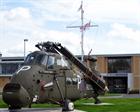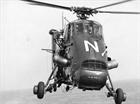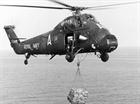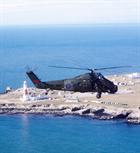Veteren Wessex takes Guard at Yeovilton
A Veteran Wessex helicopter built at Westlands Yeovil factory 48 years ago has recently been restored and stands proudly now as a Gate Guard for the Royal Naval Air Station Yeovilton.
The Westland Wessex Helicopter Utility Mark 5, serial number XT 458, came off the Yeovil production line in 1964 and first flew with the Royal Navy in June 65. The early part of its service was spread throughout the Fleet Air Arm at Lee on Solent in Hampshire and Culdrose in Cornwall. But it was when the Junglies brought their Commando Helicopter Training to Yeovilton in 1972 that XT 458, then part of 707 Naval Air Squadron, was painted in the Green colour scheme she bares today. After tours with both 845 and 846 NAS she was transferred to 772 NAS based at RNAS Portland in 1982 and flew for a further six years as a Search and Rescue aircraft. Interestingly with a distinctive Green colour scheme and Black markings. In total she flew 6,212 flying hours before being transferred to the Royal Navy’s air engineering training base at HMS Daedalus, Lee on Solent and after its closure, HMS Sultan where she was poked and prodded by fledgling air engineers.
The Junglie Sentinel arrived back at Yeovilton after the offer of the aircraft was put up for disposal from HMS Sultan.
Keen for a visual reminder of Yeovilton’s Junglie heritage it was moved to the base and lovingly restored in the colour scheme of 845 NAS circa 1974 – 1976, when she was with the squadron. In all 60 Wessex HU5’s were built for the Navy and took part in operations supporting the Royal Marines in Borneo, Oman, Northern Ireland and successfully in the Falklands during the 1982 War. In all three Wessex HU5 Squadrons from RNAS Yeovilton were deployed to the Falklands, 845, 847 and 848 NAS’s. A total of eight Wessex HU5’s were lost during Operation CORPORATE: six when the MV Atlantic Conveyor was sunk with 848 NAS and two on South Georgia with 845 NAS.
Commander Rick Fox OBE flew Wessex during the Falklands War with 845 NAS. “The Wessex 5 was built to withstand landing on rough and hostile terrain and immensely powerful, you started your flight by climbing up the outside of the aircraft to strap in to the pilot’s seat. It was agile, capable and robust multi role helicopter that could be heavily armed both in a defensive or aggressive pose, a fact that was reassuring for the crew, whether flying in the troop carrying or weapons platform role, SAR, utility or communication flight. There is little doubt that for a pilot, the Wessex V was an absolute pleasure to fly; reliable in all environments and built to last, you most definitely felt like you were in control of a powerful stallion that required respect and returned the favour.
The Wessex entered service with the Royal Navy in 1960, finally retiring their last examples in 1988. During this time the aircraft adapted well to the many roles she was asked to carry out. Initially used as a troop carrier of Royal Marines and taking loads under slung forward from Ship to shore and further into mountainous regions across the world, she also had the ability to fire missiles. In one particular incident a Wessex of 845 NAS fired two AS12 missiles at the Police station in Port Stanley, which at the time was being used by the Argentinian Military Junta.
After the Falklands the Wessex was replaced by the Sea King with the Junglies and moved to the Naval Search and Rescue Squadrons 771 and 772, XT458 serving with the latter at RNAS Portland.
Chief Petty Officer Aircrewman John Fagan flew in XT 458 during its 772 NAS days at Portland, Dorset. “It was great working in the Wessex 5 aircraft on Search and Rescue Missions around the South Coast of England and Channel Islands”. , he recalled. “We’d work a crew of three, 1 Pilot, 2 Aircrewman. As Aircrewman you had a major role, whether as the Winchman or Search and Rescue Diver on the end of the wire. It’s great to see the old girl looking so good and given pride of place front and centre at Yeovilton”.







